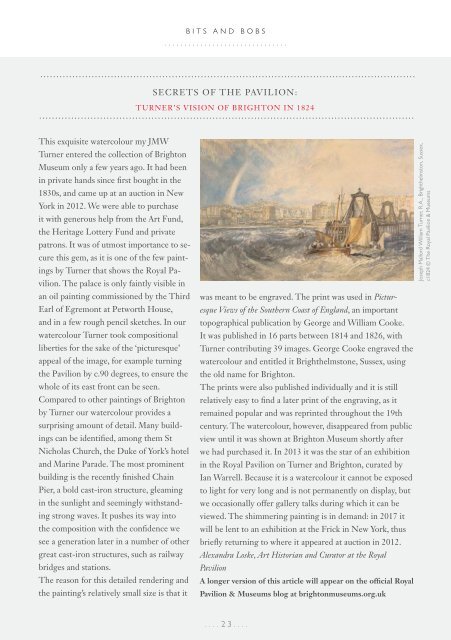Create successful ePaper yourself
Turn your PDF publications into a flip-book with our unique Google optimized e-Paper software.
BITS AND BOBS<br />
...............................<br />
SECRETS OF THE PAVILION:<br />
TURNER’S VISION OF BRIGHTON IN 1824<br />
This exquisite watercolour my JMW<br />
Turner entered the collection of <strong>Brighton</strong><br />
Museum only a few years ago. It had been<br />
in private hands since first bought in the<br />
1830s, and came up at an auction in New<br />
York in 2012. We were able to purchase<br />
it with generous help from the Art Fund,<br />
the Heritage Lottery Fund and private<br />
patrons. It was of utmost importance to secure<br />
this gem, as it is one of the few paintings<br />
by Turner that shows the Royal Pavilion.<br />
The palace is only faintly visible in<br />
an oil painting commissioned by the Third<br />
Earl of Egremont at Petworth House,<br />
and in a few rough pencil sketches. In our<br />
watercolour Turner took compositional<br />
liberties for the sake of the ‘picturesque’<br />
appeal of the image, for example turning<br />
the Pavilion by c.90 degrees, to ensure the<br />
whole of its east front can be seen.<br />
Compared to other paintings of <strong>Brighton</strong><br />
by Turner our watercolour provides a<br />
surprising amount of detail. Many buildings<br />
can be identified, among them St<br />
Nicholas Church, the Duke of York’s hotel<br />
and Marine Parade. The most prominent<br />
building is the recently finished Chain<br />
Pier, a bold cast-iron structure, gleaming<br />
in the sunlight and seemingly withstanding<br />
strong waves. It pushes its way into<br />
the composition with the confidence we<br />
see a generation later in a number of other<br />
great cast-iron structures, such as railway<br />
bridges and stations.<br />
The reason for this detailed rendering and<br />
the painting’s relatively small size is that it<br />
was meant to be engraved. The print was used in Picturesque<br />
Views of the Southern Coast of England, an important<br />
topographical publication by George and William Cooke.<br />
It was published in 16 parts between 1814 and 1826, with<br />
Turner contributing 39 images. George Cooke engraved the<br />
watercolour and entitled it Brighthelmstone, Sussex, using<br />
the old name for <strong>Brighton</strong>.<br />
The prints were also published individually and it is still<br />
relatively easy to find a later print of the engraving, as it<br />
remained popular and was reprinted throughout the 19th<br />
century. The watercolour, however, disappeared from public<br />
view until it was shown at <strong>Brighton</strong> Museum shortly after<br />
we had purchased it. In 2013 it was the star of an exhibition<br />
in the Royal Pavilion on Turner and <strong>Brighton</strong>, curated by<br />
Ian Warrell. Because it is a watercolour it cannot be exposed<br />
to light for very long and is not permanently on display, but<br />
we occasionally offer gallery talks during which it can be<br />
viewed. The shimmering painting is in demand: in 2017 it<br />
will be lent to an exhibition at the Frick in New York, thus<br />
briefly returning to where it appeared at auction in 2012.<br />
Alexandra Loske, Art Historian and Curator at the Royal<br />
Pavilion<br />
A longer version of this article will appear on the official Royal<br />
Pavilion & Museums blog at brightonmuseums.org.uk<br />
Joseph Mallord William Turner, R.A., Brighthelmston, Sussex,<br />
c1824 © The Royal Pavilion & Museums<br />
....23....


















